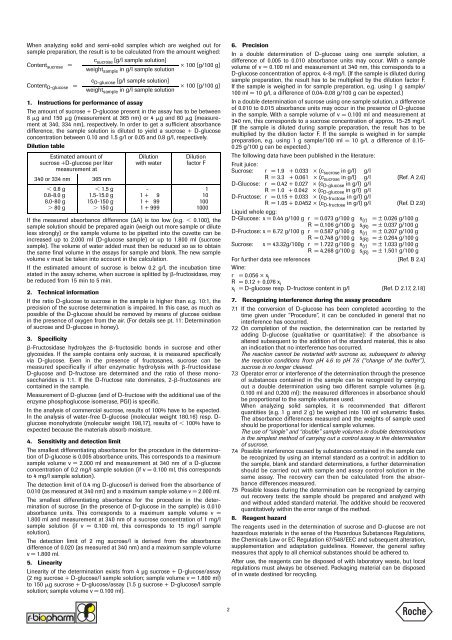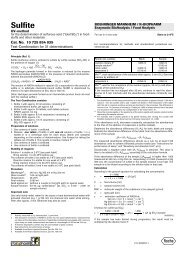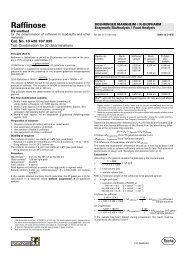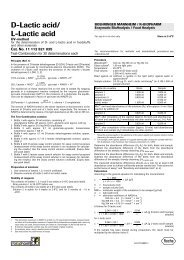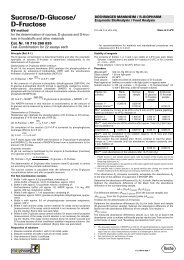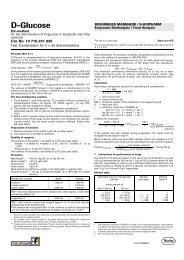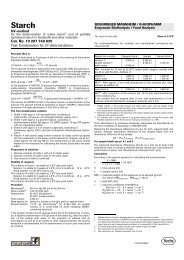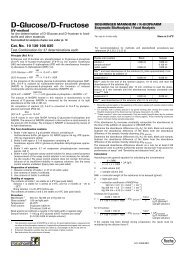Sucrose/D-Glucose
Sucrose/D-Glucose
Sucrose/D-Glucose
You also want an ePaper? Increase the reach of your titles
YUMPU automatically turns print PDFs into web optimized ePapers that Google loves.
When analyzing solid and semi-solid samples which are weighed out for<br />
sample preparation, the result is to be calculated from the amount weighed:<br />
csucrose [g/l sample solution]<br />
Contentsucrose =<br />
× 100 [g/100 g]<br />
weightsample in g/l sample solution<br />
Content D-glucose =<br />
c D-glucose [g/l sample solution]<br />
weight sample in g/l sample solution<br />
× 100 [g/100 g]<br />
1. Instructions for performance of assay<br />
The amount of sucrose + D-glucose present in the assay has to be between<br />
8 �g and 150 �g (measurement at 365 nm) or 4 �g and 80 �g (measurement<br />
at 340, 334 nm), respectively. In order to get a sufficient absorbance<br />
difference, the sample solution is diluted to yield a sucrose + D-glucose<br />
concentration between 0.10 and 1.5 g/l or 0.05 and 0.8 g/l, respectively.<br />
Dilution table<br />
Estimated amount of<br />
sucrose +D-glucose per liter<br />
measurement at<br />
340 or 334 nm 365 nm<br />
� 0.8 g<br />
0.8-8.0 g<br />
8.0-80 g<br />
� 80 g<br />
� 1.5 g<br />
1.5-15.0 g<br />
15.0-150 g<br />
� 150 g<br />
Dilution<br />
with water<br />
-<br />
1 + 9<br />
1 + 99<br />
1 + 999<br />
Dilution<br />
factor F<br />
1<br />
10<br />
100<br />
1000<br />
If the measured absorbance difference (�A) is too low (e.g. � 0.100), the<br />
sample solution should be prepared again (weigh out more sample or dilute<br />
less strongly) or the sample volume to be pipetted into the cuvette can be<br />
increased up to 2.000 ml (D-glucose sample) or up to 1.800 ml (sucrose<br />
sample). The volume of water added must then be reduced so as to obtain<br />
the same final volume in the assays for sample and blank. The new sample<br />
volume v must be taken into account in the calculation.<br />
If the estimated amount of sucrose is below 0.2 g/l, the incubation time<br />
stated in the assay scheme, when sucrose is splitted by �-fructosidase, may<br />
be reduced from 15 min to 5 min.<br />
2. Technical information<br />
If the ratio D-glucose to sucrose in the sample is higher than e.g. 10:1, the<br />
precision of the sucrose determination is impaired. In this case, as much as<br />
possible of the D-glucose should be removed by means of glucose oxidase<br />
in the presence of oxygen from the air. (For details see pt. 11: Determination<br />
of sucrose and D-glucose in honey).<br />
3. Specificity<br />
�-Fructosidase hydrolyzes the �-fructosidic bonds in sucrose and other<br />
glycosides. If the sample contains only sucrose, it is measured specifically<br />
via D-glucose. Even in the presence of fructosanes, sucrose can be<br />
measured specifically if after enzymatic hydrolysis with �-fructosidase<br />
D-glucose and D-fructose are determined and the ratio of these monosaccharides<br />
is 1:1. If the D-fructose rate dominates, 2-�-fructosanes are<br />
contained in the sample.<br />
Measurement of D-glucose (and of D-fructose with the additional use of the<br />
enzyme phosphoglucose isomerase, PGI) is specific.<br />
In the analysis of commercial sucrose, results of 100% have to be expected.<br />
In the analysis of water-free D-glucose (molecular weight 180.16) resp. Dglucose<br />
monohydrate (molecular weight 198,17), results of � 100% have to<br />
expected because the materials absorb moisture.<br />
4. Sensitivity and detection limit<br />
The smallest differentiating absorbance for the procedure in the determination<br />
of D-glucose is 0.005 absorbance units. This corresponds to a maximum<br />
sample volume v = 2.000 ml and measurement at 340 nm of a D-glucose<br />
concentration of 0.2 mg/l sample solution (if v = 0.100 ml, this corresponds<br />
to 4 mg/l sample solution).<br />
The detection limit of 0.4 mg D-glucose/l is derived from the absorbance of<br />
0.010 (as measured at 340 nm) and a maximum sample volume v = 2.000 ml.<br />
The smallest differentiating absorbance for the procedure in the determination<br />
of sucrose (in the presence of D-glucose in the sample) is 0.010<br />
absorbance units. This corresponds to a maximum sample volume v =<br />
1.800 ml and measurement at 340 nm of a sucrose concentration of 1 mg/l<br />
sample solution (if v = 0.100 ml, this corresponds to 15 mg/l sample<br />
solution).<br />
The detection limit of 2 mg sucrose/l is derived from the absorbance<br />
difference of 0.020 (as measured at 340 nm) and a maximum sample volume<br />
v = 1.800 ml.<br />
5. Linearity<br />
Linearity of the determination exists from 4 µg sucrose + D-glucose/assay<br />
(2 mg sucrose + D-glucose/l sample solution; sample volume v = 1.800 ml)<br />
to 150 �g sucrose + D-glucose/assay (1.5 g sucrose + D-glucose/l sample<br />
solution; sample volume v = 0.100 ml).<br />
2<br />
6. Precision<br />
In a double determination of D-glucose using one sample solution, a<br />
difference of 0.005 to 0.010 absorbance units may occur. With a sample<br />
volume of v = 0.100 ml and measurement at 340 nm, this corresponds to a<br />
D-glucose concentration of approx. 4-8 mg/l. (If the sample is diluted during<br />
sample preparation, the result has to be multiplied by the dilution factor F.<br />
If the sample is weighed in for sample preparation, e.g. using 1 g sample/<br />
100 ml = 10 g/l, a difference of 0.04-0.08 g/100 g can be expected.)<br />
In a double determination of sucrose using one sample solution, a difference<br />
of 0.010 to 0.015 absorbance units may occur in the presence of D-glucose<br />
in the sample. With a sample volume of v = 0.100 ml and measurement at<br />
340 nm, this corresponds to a sucrose concentration of approx. 15-25 mg/l.<br />
(If the sample is diluted during sample preparation, the result has to be<br />
multiplied by the dilution factor F. If the sample is weighed in for sample<br />
preparation, e.g. using 1 g sample/100 ml = 10 g/l, a difference of 0.15-<br />
0.25 g/100 g can be expected.)<br />
The following data have been published in the literature:<br />
Fruit juice:<br />
<strong>Sucrose</strong>: r = 1.90 + 0.0330 × (csucrose in g/l) g/l<br />
R = 3.30 + 0.0610 × (csucrose in g/l) g/l (Ref. A 2.6)<br />
D-<strong>Glucose</strong>: r = 0.42 + 0.0270 × (cD-glucose in g/l) g/l<br />
R = 1.00 + 0.0420 × (cD-glucose in g/l) g/l<br />
D-Fructose: r = 0.15 + 0.0330 × (cD-fructose in g/l) g/l<br />
R = 1.05 + 0.0452 × (cD-fructose in g/l) g/l (Ref. D 2.9)<br />
Liquid whole egg:<br />
D-<strong>Glucose</strong>: x = 0.44 g/100 g r = 0.073 g/100 g s (r) = ± 0.026 g/100 g<br />
R = 0.106 g/100 g s (R) = ± 0.037 g/100 g<br />
D-Fructose: x = 6.72 g/100 g r = 0.587 g/100 g s (r) = ± 0.207 g/100 g<br />
R = 0.748 g/100 g s (R) = ± 0.264 g/100 g<br />
<strong>Sucrose</strong>: x = 43.32g/100g r = 1.722 g/100 g s (r) = ± 1.033 g/100 g<br />
R = 4.268 g/100 g s (R) = ± 1.501 g/100 g<br />
For further data see references (Ref. B 2.4)<br />
Wine:<br />
r = 0.056 × xi R = 0.12 + 0.076 xi xi = D-glucose resp. D-fructose content in g/l (Ref. D 2.17, 2.18)<br />
7. Recognizing interference during the assay procedure<br />
7.1 If the conversion of D-glucose has been completed according to the<br />
time given under “Procedure”, it can be concluded in general that no<br />
interference has occurred.<br />
7.2 On completion of the reaction, the determination can be restarted by<br />
adding D-glucose (qualitative or quantitative): if the absorbance is<br />
altered subsequent to the addition of the standard material, this is also<br />
an indication that no interference has occurred.<br />
The reaction cannot be restarted with sucrose as, subsequent to altering<br />
the reaction conditions from pH 4.6 to pH 7.6 (“change of the buffer”),<br />
sucrose is no longer cleaved.<br />
7.3 Operator error or interference of the determination through the presence<br />
of substances contained in the sample can be recognized by carrying<br />
out a double determination using two different sample volumes (e.g.<br />
0.100 ml and 0.200 ml): the measured differences in absorbance should<br />
be proportional to the sample volumes used.<br />
When analyzing solid samples, it is recommended that different<br />
quantities (e.g. 1 g and 2 g) be weighed into 100 ml volumetric flasks.<br />
The absorbance differences measured and the weights of sample used<br />
should be proportional for identical sample volumes.<br />
The use of “single” and “double” sample volumes in double determinations<br />
is the simplest method of carrying out a control assay in the determination<br />
of sucrose.<br />
7.4 Possible interference caused by substances contained in the sample can<br />
be recognized by using an internal standard as a control: in addition to<br />
the sample, blank and standard determinations, a further determination<br />
should be carried out with sample and assay control solution in the<br />
same assay. The recovery can then be calculated from the absorbance<br />
differences measured.<br />
7.5 Possible losses during the determination can be recognized by carrying<br />
out recovery tests: the sample should be prepared and analyzed with<br />
and without added standard material. The additive should be recovered<br />
quantitatively within the error range of the method.<br />
8. Reagent hazard<br />
The reagents used in the determination of sucrose and D-glucose are not<br />
hazardous materials in the sense of the Hazardous Substances Regulations,<br />
the Chemicals Law or EC Regulation 67/548/EEC and subsequent alteration,<br />
supplementation and adaptation guidelines. However, the general saftey<br />
measures that apply to all chemical substances should be adhered to.<br />
After use, the reagents can be disposed of with laboratory waste, but local<br />
regulations must always be observed. Packaging material can be disposed<br />
of in waste destined for recycling.


